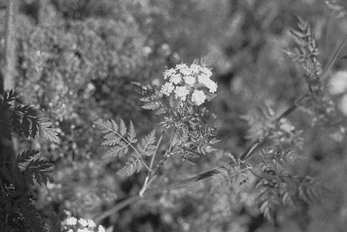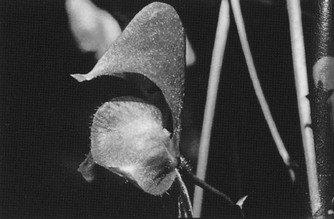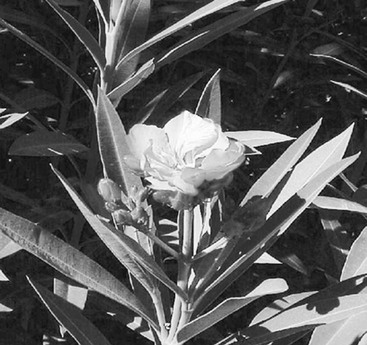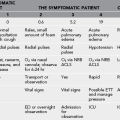Toxic Plants
Toxic Plant Ingestions
Organ System Principles
Central Nervous System
Jimsonweed (Fig. 40-1)
Symptoms may appear within minutes and may last for days. These include the following:
Deadly Nightshade
Treatment
1. Provide decontamination and supportive care, including oral administration of activated charcoal, airway protection, intravenous (IV) fluids, and vasopressors for hypotension resistant to IV fluids.
3. Agitation can be treated with administration of a benzodiazepine. Haloperidol and phenothiazines should not be used because these agents may enhance toxicity.
4. Foley catheterization and nasogastric tube placement may be necessary if bladder distention and decreased gut motility develop, respectively.
Tobacco Plants
Nicotinic Syndrome
Conium maculatum (poison hemlock) (Fig. 40-2) is also known as spotted hemlock, California or Nebraska fern, stinkweed, fool’s parsley, and carrot weed. It has a mousy odor and unpleasant bitter taste and burns the mouth and throat. All plant parts are poisonous; the roots are especially toxic. Poisoning may also occur after eating birds that have consumed poison hemlock.

FIGURE 40-2 Poison hemlock (Conium maculatum).
Initially, stimulation causes:
Betel Nut
Areca catechu (areca palm) produces betel nut.
Clinical effects resemble nicotinic syndrome and cholinergic toxicity:
1. CNS effects (dizziness, euphoria, subjective arousal, altered mental status, hallucinations, psychosis, convulsions)
2. Cardiac effects (tachycardia, hypertension, palpitations, arrhythmias, bradycardia, hypotension, chest discomfort, and acute myocardial infarction in susceptible individuals)
3. Pulmonary effects (bronchospasm, tachypnea, dyspnea), GI effects (salivation, vomiting, diarrhea)
4. Urogenic effects (urinary incontinence) and musculoskeletal effects (weakness and paralysis)
5. Other: flushing, diaphoresis, warm sensations, red- or orange-stained oral mucosa and saliva, and dark brown– or black-stained teeth
Quinolizidine Alkaloids
Treatment
1. Supportive care with particular attention to airway protection and ventilation is necessary.
2. Seizures should be treated with benzodiazepines and barbiturates.
3. Treat with IV fluids to ensure adequate urine output (1 mL/kg/hr).
4. Urine may be alkalinized with IV sodium bicarbonate to achieve a urine pH of 7.5.
5. Treating initial excessive adrenergic stimulation with phentolamine is not advised because this complicates the nicotinic blockade that follows.
6. Symptomatic bradycardia can be treated with atropine, and hypotension with IV fluids and inotropic agents (e.g., dopamine) if needed.
Hallucinogenic Plants
Nutmeg (Myristica fragrans)
Nutmeg contains myristicin, which is metabolized to amphetamine-like compounds.
Cannabis (Cannabis sativa)
The primary psychoactive component is most concentrated in the flowering tops.
Neuromuscular Blocking Plants (Indole Alkaloids)
Strychnine
Strychnine, found in seeds of the tree Strychnos nux-vomica, is a powerful CNS stimulant.
Symptoms
1. Early symptoms are primarily GI, including abdominal pain, vomiting, and diarrhea
2. Profuse perspiration, salivation, and respiratory distress
3. Tachycardia and hypertension or bradycardia and hypotension
4. Epileptiform seizure activity or spastic and tonic movements, including opisthotonus without seizure activity
6. Rhabdomyolysis and renal failure
7. Death associated with persistent seizures, cerebral edema, ventricular fibrillation, pulmonary edema, cardiopulmonary arrest, and disseminated intravascular coagulation
Cardiovascular System
Cardiotoxins That Inhibit Na+, K+-ATPase (Cardiac Glycosides)
Cardiac glycosides are found in Digitalis purpurea (foxglove; Fig. 40-3), Digitalis lanata, Nerium oleander (common oleander; Fig. 40-4), Thevetia peruviana (yellow oleander), Convallaria majalis (lily of the valley), Urginea maritima (squill or sea onion), Urginea indica, Strophanthus gratus (ouabain), Asclepias spp. (balloon cotton, red-headed cotton bush, milkweeds), Calotropis procera (king’s crown), Carissa spectabilis (wintersweet), Carissa acokanthera (bushman’s poison), Cerbera manghas (sea mango), Plumeria rubra (frangipani), Cryptostegia grandiflora (rubber vine), Euonymus europaeus (spindle tree), Cheiranthus, Erysimum (wallflower), and Helleborus niger (hellebore).
Clinical Presentation
2. Visual changes (yellow and green colors, “halos,” geometric shapes, scintillations, photophobia)
3. Mental status changes (disorientation, psychosis, lethargy, stupor, dysarthria, weakness, dizziness, seizures)
4. Cardiac disturbances (palpitations, bradycardia, atrioventricular block, sinus node block, extrasystoles, ventricular arrhythmias, syncope)
6. When death occurs, it is generally caused by cardiotoxicity.
Steroid Alkaloids Cardiotoxins that Block Sodium Channels
Steroid alkaloids form principal toxic components of several common cardiotoxic plants: Aconitum spp. (monkshood; Fig. 40-5), Veratrum viride (American hellebore), and Zigadenus spp. (death camas).

FIGURE 40-5 Monkshood (Aconitum spp.).
Symptoms
1. Begin within 3 minutes to 6 hours of ingestion and may persist for several days
7. Cardiac effects are clinically similar to cardiac glycoside toxicity, with enhanced vagal tone, bradycardia, heart block, ectopic beats, supraventricular tachycardia, bundle branch block, junctional escape rhythms, ventricular tachycardia, bifascicular ventricular tachycardia, polymorphic ventricular tachycardia, torsades de pointes, ventricular fibrillation, asystole, and hypotension
8. Occasionally death ensues, generally from ventricular arrhythmias such as refractory ventricular fibrillation
Veratrum Alkaloids
Veratrum and Zigadenus species belong to the lily family.
Symptoms
1. Generally occur within 30 minutes to 3 hours and resolve within 24 to 48 hours
2. Diaphoresis, nausea, vomiting, diarrhea, abdominal pain, hypotension, bradycardia, arrhythmias, and shock
3. Syncope, respiratory depression, scotomata, paresthesias, fasciculations, muscle spasticity, hyperreflexia, vertigo, ataxia, dizziness, coma, seizures, and death may also occur
Treatment
1. Treatment of cardiotoxic steroid alkaloid poisoning is supportive and includes atropine, crystalloid fluids, and vasopressors.
2. Patients may require mechanical ventilation and cardiopulmonary resuscitation.
3. Magnesium may suppress ventricular tachycardia.
4. Lidocaine, amiodarone, and hemoperfusion have been also been used to treat ventricular arrhythmias.
Oral and Gastrointestinal System
Symptoms
1. Fulminant gastroenteritis with vomiting and diarrhea 2 to 4 hours after ingestion
2. Diarrhea may appear foamy from the sudsing effect of saponin glycosides
3. Hypotension may follow significant GI fluid losses
4. Severe ingestions may result in weakness, loss of consciousness, seizures, and respiratory depression
Toxins That Inhibit Protein Synthesis (Phytotoxins)
Phytotoxins (Ricin, Abrin)
Phytotoxins are found in the families Fabaceae, including Abrus precatorius (jequirity bean, rosary pea, prayer bead), which contains abrin, and Euphorbiaceae, including the Ricinus communis (castor bean), which contains ricin (Fig. 40-6).
Symptoms
1. The oral lethal dose is estimated to be 1 mg/kg, theoretically as little as 1 castor bean in a child and 8 to 10 in an adult.
2. There is a latent period of 1 to 6 hours, followed by nausea, vomiting, diarrhea, hemorrhagic gastritis, abdominal pain, thirst, dehydration, hypotension, and shock.
3. Death may occur from dehydration and electrolyte imbalances; convulsions may precede death. Death usually occurs after 72 hours because of multiorgan failure.
Toxins That Inhibit Cell Division
Symptoms
1. Acute poisoning may occur after a latent period of several hours.
2. Initial GI effects are severe abdominal pain, nausea, vomiting, diarrhea, and hemorrhagic gastroenteritis.
3. Electrolyte abnormalities, volume depletion, acidosis, shock, arrhythmias, and multiorgan failure occur.
4. Muscular weakness and ascending paralysis may cause respiratory arrest, which may occur with a clear sensorium.
Plants That Inhibit Cellular Respiration
Symptoms
1. GI distress, bitter almond breath
2. CNS (agitation, anxiety, excitement, weakness, numbness, hypotonia, spasticity, coma, seizures)
3. Respiratory (hyperpnea, dyspnea, apnea, cyanosis)
4. Cardiovascular (tachycardia and hypertension followed by bradycardia and hypotension, heart block, ventricular arrhythmias, asystole)
Treatment
2. Treat cyanide poisoning with hydroxocobalamin at an IV dose of 5 g for adults (70 mg/kg for children); may be repeated for a total dose of 10 g in adults.
3. Alternative cyanide antidote therapy includes amyl nitrite pearls, sodium nitrite, and sodium thiosulfate (cyanide antidote kit), but these are being phased out and may be unavailable in some locations.
4. Supportive care, including mechanical ventilation, IV fluids, and vasopressor as needed
Plant-Induced Dermatitis
Irritant Contact Dermatitis
Signs and Symptoms
1. Caused by direct contact with the offending plant
2. Most of these rashes are mild and self-limited, typically involving 1% to 2% of body surface area.
3. Irritant contact dermatitis causes transient redness and pruritus of the contacted skin.
4. The spectrum of reactions ranges from linear scratch marks to weeping, ulcerated, red scaly plaques.
Treatment
1. Remove patient from exposure to the irritant chemicals, or ensure barrier protection using clothing.
2. Gently cleanse the wound with antibacterial soap, apply cool compresses, and watch for infection.
3. Administer antihistamines, such as hydroxyzine 10 to 25 mg PO qid, or diphenhydramine, 25 mg PO bid to qid.
4. A topical medium-strength steroid, such as triamcinolone 0.1% cream, may be applied twice a day to the affected areas for up to 2 weeks.
5. Clobetasol 0.05% cream or ointment (an ultrapotent topical steroid) can also be used in severe cases.
6. In the case of topical medium-strength and ultrapotent topical steroids, care should be taken to avoid application to the groin, axillae, and face.
7. Typical steroid application regimens are twice daily for 1 to 2 weeks.
8. Cool compresses with aluminum acetate solution (Domeboro, Burow’s solution) diluted 1 : 40 in water are very helpful in soothing pruritus and exudative skin irritation.
9. Dermatitis generally heals in less than 7 days if no complications develop and if tissue damage is minimal.
Allergic Contact Dermatitis
Signs and Symptoms
1. The most common acute presentation is linearly arranged eczematous, edematous patches and plaques with varying amounts of vesiculation and bulla eruption.
2. Occasionally the eruption is widespread.
3. If the face is involved, there can be severe eyelid swelling and patients may be quite distressed by their appearance.
4. In severe cases, patients can have systemic symptoms of fever, chills, fatigue, and lethargy.
5. In its more chronic form, allergic contact dermatitis presents with lichenified eczematous plaques in exposed areas.
Treatment
1. Systemic corticosteroids are the first line of treatment for moderate to severe disease.
2. In mild cases, use an ultrapotent topical steroid alone, such as clobetasol 0.05% ointment twice daily to the affected areas for 2 weeks.
3. If the reaction is of less than 2 hours’ duration, IV hydrocortisone (adult dose 100 to 200 mg) or methylprednisolone (adult dose 500 mg to 1 g) can be curative.
4. After a patient has suffered 4 to 6 hours with massive edema, erythema, and pruritus, IV therapy is highly effective, but it must be followed by more prolonged oral or intramuscular administration of corticosteroids for 2 to 3 weeks.
5. If presenting after 8 to 16 hours, administer prednisone, 1 mg/kg/day up to 60 mg/day for 3 to 4 days followed by a slow taper over 2 to 3 weeks.
6. A bath with 1 cup of Aveeno oatmeal per tub of water, in addition to therapy with an antihistamine, such as hydroxyzine or diphenhydramine, is helpful for the itching.
7. Together, pimecrolimus (Elidel) 1% cream and tacrolimus (Protopic) 0.03% and 0.1% creams, represent new topical immunomodulators that offer a noncorticosteroid treatment alternative.
Contact Urticaria
Treatment
1. All patients with a risk for severe urticaria should carry an self-administered epinephrine injection with them at all times.
2. Other supportive treatments for anaphylactic shock, such as histamine1 (H1) and histamine2 antagonists, IV steroids, albuterol, and oxygen, may be required. IM or IV diphenhydramine (Benadryl), in an adult dose of 25 to 50 mg, usually stops progression of wheal formation and can be followed by oral hydroxyzine (10 to 25 mg tid) or cyproheptadine (4 mg tid) for 2 to 5 days.
3. Pure H1 blockers, such as fexofenadine (60 mg bid), are also effective and do not depress the central nervous system.










